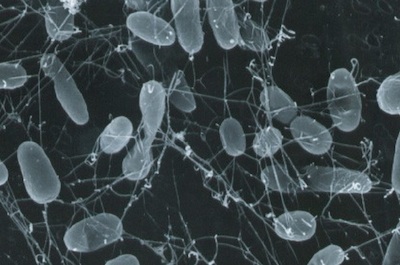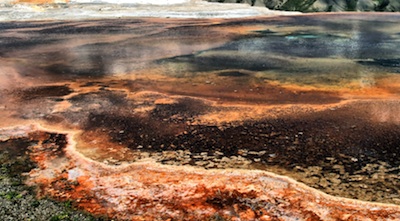



|

|

NAM 2013: Earth's fate offers signature for dying planets
BY KEITH COOPER
ASTRONOMY NOW
Posted: 2 July 2013

Predicting the fate of life on our planet over two billion years into the future could help us search for evidence for primitive life on once-habitable exoplanets around brightening stars, according to new research presented this week at the Royal Astronomical Society's National Astronomy Meeting in Scotland.

An example of an 'extremophile': heat-loving bacteria called thermophiles. Such lifeforms will be the last inhabitants of Earth. Image: Mark Amend/NOAA Photo Library.
The Sun is ever brightening. We don't notice it on human timescales, but over the course of hundreds of millions, turning into billions of years, it has a dramatic effect on our planet's climate. In the past the Sun was fainter, leading to what Carl Sagan termed the Faint Young Sun paradox, whereby Earth received less solar heating yet still seemed warm enough for life to begin (it has been speculated that cloud cover and greenhouse gases ejected into the atmosphere by volcanoes helped to keep Earth snug).
However, the Sun will continue to increase in luminosity and in a billion years Earth will be far too hot for any life to exist on the surface. Rainfall will increase first, removing carbon dioxide from the atmosphere, causing plants to die, instigating a drop in oxygen levels and, without plants and oxygen, animals including humans will also perish. Microbes will be all that is left on the planet and they'll persevere on the surface for a billion more years, says Jack O'Malley-James of the University of St Andrews, who has simulated the timeline of extinction events based on extreme long-range temperature forecasts for the Earth as the Sun's luminosity increases. At this point only the hardiest microbes - extremophiles with a fondness for heat and ultraviolet radiation - will survive and even they will have to retreat underground to where the last few pockets of liquid water lie.

The Upper Geyser Basin in Yellowstone National Park resembles the Sun-scorched landscape of the future Earth.
"The far-future Earth will be very hostile to life by this point," says O'Malley-James. "All living things require liquid water, so any remaining life will be restricted to pockets of liquid water, perhaps at cooler, higher altitudes or in caves or underground." Yet 2.8 billion years from now even these final inhabitants of planet Earth will be gone as temperatures rise and our planet is rendered a scorched wasteland.
Although the fate of Earth's life has been well chronicled, O'Malley-James' simulations allow the intriguing possibility of detecting the last inhabitants on exoplanets suffering a similar drawn out heat death. It will not be an easy detection, however, and is likely beyond our current capabilities. Currently, life on Earth would be detectable from afar thanks to the concentration of oxygen and ozone in our atmosphere. For a scorched planet, however, oxygen and ozone will have long since vanished, according to O'Malley-James.
"We have now simulated a dying biosphere composed of populations of the species that are most likely to survive to determine what types of gases they would release to the atmosphere," he says. "By the point at which all life disappears from the planet, we're left with a nitrogen/carbon dioxide atmosphere with methane being the only sign of active life."
|

|

|

|
|



